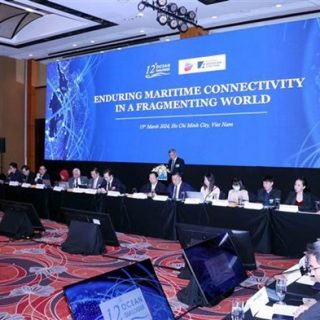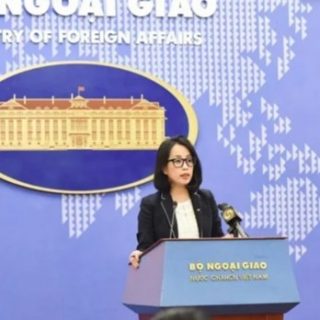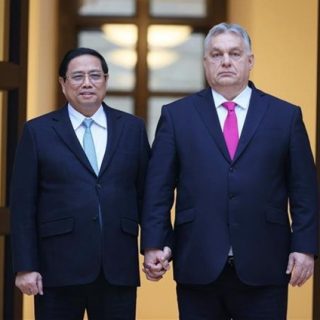Session 1: Security situation
Just like land security, maritime security includes both traditional security and non-traditional security. Under this framework, the paper focuses on analyzing some of the main contents of non-traditional security that threaten the security of the South China Sea region during the first two decades of the 21st century.
Maritime security is an integral part of the security of the coastal state, island nation and archipelago nation in the world. To a large extent, maritime security is also a component of regional and world security, closely linked to many of the continental security issues. At present, 70% of the world’s population lives on coastal islands and archipelagos, and most of the major national, international economic, political and cultural centers are located close to the sea. Consequently, maritime security has increasingly had a major impact on the inland security of coastal and island states.
Maritime security is understood to be a stable, safe, non-threatening state that derives from the sea and lands to the normal activities of states, organizations and individuals at sea or to the activities of countries, organizations and individuals on land. So, like land security, maritime security includes both traditional security and non-traditional security. According to this framework, the paper focuses on analyzing some of the key contents of non-traditional security that threaten the security of the South China Sea area during the first two decades of the 21st century, including piracy, smuggling, seizure of fishing grounds, and the obeyence of the law by means of navigation at sea.

The situation of maritime security in the South China Sea area
Piracy continues to increase
During the first two decades of the twenty-first century, the security situation in the South China Sea area raises the issue of piracy and armed robbery against ships while circulating through this important sea. This is considered to be one of the biggest challenges for maritime transport in the maritime economy of the world, especially in the South China Sea.
The active area of piracy in the South China Sea is mainly concentrated in two places, the Strait of Malacca and the Sulu-Celebes Strait. Located between the Malay Peninsula and the Indonesian island of Sumatra connecting the South China Sea and the Indian Ocean, the Straits of Malacca has a length of 805 km, the narrowest of which is only 1.2 km and is the main shipping route from Europe and the Americas, Africa, Middle East, South Asia to Southeast Asia and East Asia. Every year, about 50,000 crossings occupy a quarter of the total number of vessels operating worldwide. With its favorable geographic position and bustling sea economy, especially in the shipping sector, the Malacca Strait is considered to be the ideal location for Southeast Asian pirates.
The Sulu-Celebes Strait is located between the Philippines, Malaysia and Indonesia. Currently, the area is considered by the International Maritime Bureau (IMB) to be the most risky place of maritime activity in the world because this is a large scale operation of the pirate group and armed robbery against Southeast Asia’s most aggressive ship, under the control of the Abu Sayyaf Islamic militant group, is based in the southern Philippines, Abu Sayyaf. It is a complex terrain area with thousands of large and small islands and countless villages, caves, canals, alleyways, etc. Malacca Strait has natural conditions that are easy for pirate groups to handle ambushes, attack targets, evade functional forces, and transport looted goods to land for consumption. Apart from these two hotspots, the southern part of the South China Sea linking Singapore with the Anamba Islands and Indonesia’s Natuna Islands is also a relatively active area of Southeast Asian piracy.
As in the past, South Pacific piracy attacks only slow-moving, low-side cargo ships or coal-hauling barges from Indonesia to the southern Philippines, now pirate and armed robberies on the sea front has become more aggressive, extend attack objects to large cargo ships, oil tankers and fishing vessels, etc. However, the target most preferred by Southeast Asian pirates remains freighter and liquid carrier, because each hijacked tanker can give them hundreds of thousands or even millions of dollars.
About piracy operations, vehicles and armed robbery against ships, according to the conclusion of the Asian Piracy Association [3], based in Singapore, the pirates of the Pacific Southeast Asia is a very dangerous, organized group of pirates. They operate boldly and recklessly, based on highly accurate internal information sources, and at the same time proactively collect informations in a variety of sources such as bribery of metamorphosed sailors, ports, even news from some government officials and corrupt military, etc … Thanks to the source, the pirates have a very firm grasp of what cargo targets to attack, time and ship’s voyage, as well as security measures on board, and so on, so they can pursue a long course in the long haul from the time the ship leaves the port, or they can accurately pick up the target ships.
Pirates and armed robbers have a variety of weapons, equipped to fight ships. The means of piracy in the South-East Asian seas is also varied, including wooden boats pretending to be fishermen, modern high-speed trains to keep them out of flight; GPS positioning device; knife, submachine gun and machine gun. Pirates and armed robbers against boats often use high speed boats, which have large boats that they steal for use as a means of transport.
When the time comes, the pirates immediately accelerate to reach the target, break into the ship, beaten, threaten, seize the crew; break the communications, cut off communications, force sailors to slow down their slow-moving ships in order to prolong their ship’s waiting time for shipments. At the same time, they also actively contacted authorities and carriers for hostage ransom, including up to tens of millions of dollars. In addition, during congested and unobstructed airfares, they can attack fishing boats or any ships they encounter at sea.
In the Straits of Malacca- Singapore, taking advantage of the dense traffic of boats, pirates easily mix in the crowd to snatch the goods. They use small vessels of large capacity against the target ship to open daytime delivery as a normal delivery activity without fear of functional forces or nearby trains being detected, The radar image is just a dot, and the sailors of the ship are robbed and can not ring the alarm even when the naval patrol ships pass by, because the sailors on board have been seized. The hacker was buried in the cellar or guns on the head. After successfully hijacking, the pirates trap all the crew and then withdraw smoothly. When the task force discovered, it was too late, so many of the oil tankers in the waters were attacked by daytime pirates. Typical in this area include three robberies occurring in 2015, including the May 2 robbery of Ocean Energy; The Oriental Glory on May 15 and the Orkim Harmony on June 11, resulting in 6000 tons of RON 95 gasoline (more than 7 million liters), 2023 tons of gas and 2500 tons of oil with a total value of more than $ 10 million were hijacked.
In the Sulu Strait area, the Abu Sayyaf pirates often organize ambushes along the route from the East Sea to the Western Pacific and the sea lanes linking the Philippines, Malaysia and Indonesia. When the target appears, the party will follow, wait until the evening or when the crew loses alertness to act. This group can detain ships from 7-10 days to find customers to consume goods without fear of detection function. The Abu Sayyaf pirates are particularly dangerous, in addition to robbery, they kidnap sailors for ransom, they are ready to kill hostages if their requests are not met. In the past two years, the Abu Sayyaf crew has arrested Malaysian, Indonesian and Filipino sailors. On February 19, 1977, the group attacked the Vietnamese ship Jiang Hai in the waters above, shooting dead sailor Vu Duc Hanh, arrested six others after smashing many vehicles and drifting away. Earlier on November 13, the Royal Navy of Vietnam Royal Marine Joint Stock Company was attacked by the Abu Sayyaf pirate group, seizing six sailors after injuring one man.
Smuggling and commercial fraud on the sea
Along with the piracy raging, the smuggling and trade frauds in the sea in Southeast Asia also increased sharply in number of cases, objects as well as arrested exhibits. Although there is not much evidence, many experts in the South China Sea study said that the sea smuggling forces are tolerating and the main consumer channel for selling pirate goods. In the waters of Vietnam, smuggling and trade frauds are happening, with gas, oil, coal, titan ore, wood and drugs being the most common. From 2012 to September 2015, the Coast Guard and Border Guards separately found and detained in the Southwest Economic Exclusive Zone; in the coastal areas of Quang Ninh, Hai Phong, Nghe An, Ba Ria – Vung Tau, Soc Trang 69 seizures with 7 out of 45 traffickers being foreigners, confiscated 21.773.682 liters gasoline, oil of all kinds, collected 280 billion Dong for state budget. In 2016, the Border Guards force detects and arrests 213 cases/ 563 subjects, collecting more than 10 million liters of petrol, the typical of which is the transport of more than 5 million liters of gulled oil by a foreign ship into Vietnam in Phu Yen, semi-commercial sale of the total amount of remittances to the budget of 61 billion; captured 68 cases / 124 subjects, seized 88.762 tons of coal, 6.770 m3 of sand, 65.589 bags of foreign cigarettes, more than 2 tons of firecrackers and many other valuable items, collected 145.8 billion Dong. In the first quarter of 2017, the force continued to seize 1.514.000 liters of petrol, 2.574.190 liters of oil, 15.829 tonnes of coal, more than 100.000 cigarettes, more than 3 tonnes of firecrackers, 4 kilograms of heroin, and 10.5 kilograms opium, etc.; the total value of material evidences temporarily kept about 151.2 billion Dong.
In terms of tricks for petroleum products, the domestic groups are closely associated with foreign objects using ships or boats that do not hold national flags or converted ships to transship oil purchased from foreign ships in adjacent waters. Some of the gasoline and gonad is sold directly to fishermen in fishing grounds. More sophisticated, the local producers also established many legal entities in the petroleum business in the local area, taking advantage of the sale and transportation between companies to legalize the purchase of oil illegally purchased from foreign vessels for domestic consumption. Whenever ships carrying gasoline and oil arrive in Vietnam’s sea, they immediately notify the smaller ships to the conventional site to move to the mainland, divided into land. Vessels take goods in their contracts, short sale invoices between companies within the same system, after receiving the oil, the contract finalizers and vouchers are matched with the goods received for transfer to the warehouse or take away for consumption.
There are also many businesses hiding under the guise of importing petroleum, but the volume of petroleum is just 1/3 to 1/5 of the actual import amount for tax fraud. Typically, bulk fraud of Duong Dong Hoa Phu Company in Hoa Phu, Tuy Phong, Binh Thuan. On January 29, 2016, the General Department of Customs has examined and caught the Singapore-based CHRISTINA Tanker which was pumping gasoline into the warehouse for this company. According to the customs declaration number 100726667900, the company reported that the quantity of RON 92 imported was 1.877,5 tons, but the actual import volume was 9.373,6 tons, 5 times more the amount declared and cheat 10.593,076 liters Moreover, in the context of illegal trade, they now usually do not using cash, the transfer through bank onshore bank international oil smuggling procedures are closed, very difficult to detect.
In addition, the situation of smuggling coal and minerals in the South China Sea area has complicated many times, the heat only ranked second after smuggling gasoline. Tricks are also more reckless and sophisticated. Buyers of coal from many sources, using the records, invoices, used vouchers which modify the date and month to reuse to validate the source. Moreover, because of the variety of coal, making it very difficult for functional forces to determine the true quality and price of the shipment. Since verification takes a lot of time, subjects easily use counterfeit invoices to bypass the authority. Not only that, coal transport vehicles are well-invested by investors, often large-capacity vehicles, anchored offshore, employing experienced sailors, taking advantage of the dark night, bad weather to take small vessels to transport coal from the inland; this makes it difficult for specialized forces in the process of deploying forces to capture. In addition, to divert functional forces, smugglers paint the ship’s name change, or for the means of loops to avoid locks, border stations, disguised as inland transportation but when reaching the delimitation line in The Northern Bay suddenly surged to change direction to China.
In drug trafficking, the United Nations Office on Drugs and Crime says that Southeast Asia is currently the world’s largest integrated drug producer with pre-packaged drug substance supply granted from India, China. Meanwhile, drug traffickers formed in the Middle East, West Africa are opting for Southeast Asia as a place to consume or transit narcotics into third countries, which are linked to drug trafficking in Latin America to organize the shipment of cocaine to Southeast Asia by sea. According to the functional forces, drug shipments by sea are often very large. Moreover, sea transport makes the fight against crime more difficult than road and air, because of the wide area, easy to hide, easy to mourn, while the nation’s blocking forces are very small.
If innocent domestic criminals often use fishing boats, passenger ships, small transport ships to transport drugs at high winds, international drug cartels are transported on board super-weigh, hide in the container. If the source of the search does not detect the drug, the functional forces will face international lawsuits. In addition to these facilities, criminals also use submarines to transport drugs. Typical examples of drug shipments by sea were discovered in Vietnam: the arrest of the police at the toll station of Highway 6 Luong Son, Hoa Binh on March 18, heroin is on the way to port; or the capture of a container concealed of 2.8 tons of dried thirst leaves on March 21, 2017 at Tan Vu port, Hai Phong, which is a leaf that has amphetamine-like stimulant but has a faster action and many times more dangerous than rock drugs. Previously, on May 20, 2015, the Drug Enforcement Police in cooperation with the Hong Kong Police arrested two En Xanvado and one Colombian seized at Cat Lai Port Ho Chi Minh City 31.6 kg of cocaine and block of 16.9 kg of cocaine being transported from Hong Kong’s port of Hai Phong are all well documented in containers or the capture of 490 cakes of heroin hidden in bottles. Industrial gas ships carrying thousands of tons in July 2015.
Intrusion of the sea to catch fishery
Under the Fishery Cooperation Agreement in the Gulf of Tonkin signed between the Government of China and the Government of Vietnam in 2000, the two sides established a 33.500 km2 general fishing area, which range from the 20th parallel down to the closed road of the bay gate, 30.5 nautical miles from each side. Vietnam has about 2.500 boats and China has about 1.000 licensed vessels. However, due to the large area, the regular patrol force of Vietnam for many years has only 6-8 ships, so the number of unlicensed vessels mixed with the vessels allowed to catch fishing vessels to illegally exploit seafood and smuggling are huge. Each year, in this area the Vietnamese functional forces have detected, processed and disposed of 1.200 Chinese vessels in violation. In the waters of the Paracels and Spratly Islands, Chinese fishing vessels spill over fishing grounds, chase fishing boats. They even went to the convoy of hundreds of ships to penetrate into the territorial waters, for example only 5km to the Indonesian island of Natuna to catch fish, ready to sink fishing vessels of other countries. China’s cruise ships and hatchets, freed for their fishing boats, were arrested and detained by functional forces. Recently, in the waters of the provinces from Quang Ngai to Binh Thuan, Vietnam’s functional forces have discovered and repelled many foreign invaders, including hundreds of strikes. Not only did they sink into Vietnamese fishing boats, they jumped on Vietnamese fishing boats, beat up fishermen, robbed many of their assets, etc., making maritime security very complex. Typically, on the 16th of May 1414, the fishing vessel of the Quang Ngai fishermen was hit by the Chinese vessel number 306, seriously wounded captain Nguyen Tan Hai and a fisherman, robbed 8 tons of seafood, communication equipment and more than 2.000 liters of diesel oil; or the fishing vessel of Quang Nam fishermen QNa-95861 TS was hit by a strange ship on November 26, 2015, shot dead Mr. Truong Cong Bay. On 03/5/2016, Pham Phu Thanh’s Quang Nam QNa-95959TS was also attacked by a strange vessel near two nautical miles and sunk in the Hoang Sa waters. Fortunately, 34 fishermen were taken by Pham Phu Trung’s ship which came to help. In addition to submerging Vietnamese fishing boats, some strange boats also prevented Vietnam’s fishing boat to save fishermen and made public opinion very discontented.

Due to the lack of navigation equipment and the loss of fishing grounds, in 2016, many Vietnamese fishermen have washed up in overlapping waters with Indonesia, Malaysia, Thailand, the Philippines, etc., to exploit seafood and were arrested. In particular, Indonesia has arrested more than 400 Vietnamese fishermen, captured and destroyed many fishing vessels of Vietnamese fishermen, Malaysia arrested 10 vessels and 87 fishermen, Thailand captured 17 ships, holding 113 fishermen, two people and a missing person. In addition, the safety of maritime traffic in the South China Sea is also a problem due to the large volume of daily traffic. In 2016 and the first quarter of 2017, dozens of large cargo ships sank small or medium sized fishing ships or trains and fled, ignoring search and rescue responsibilities. Many Vietnamese ships are victims with very heavy consequences. Among these cases, the fishing vessel number QB-3969TS of resident Nguyen Van Hoa residing in Quang Trach district, Quang Binh, was sank on March 20 near Hon La island 92 miles east; or a marine accident occurred between Hai Thanh 26 and 14 Petrolimex vessels on 28 March Vung Tau seaports caused Hai Thanh ship collapsed and caused 9 crew died.
Dr. Nguyen Thanh Minh, Marine Police Command
Session 2: A number of mechanisms for cooperation and forecasting of the upcoming situation
Key References:
- See also Nguyen Thanh Minh (2016), Combating Piracy, Armed Robbery in Asia-Pacific and Current Issues, Journal of International Relations, No. 33.
- Pirates of South East Asia, Youth, September 23, 2016.
- Pirates change tactics, how ships react, Journal of Traffic, March 5, 2017.
- Piracy in Southeast Asia, Saigon Economic Times, 18/11/2016.
- Southeast Asia faced piracy, workers, March 30, 1977.
- About 400 Vietnamese fishermen are being held by Indonesia, Youth, on 22/8/2016.
7. Causes of fishermen arrested abroad, VTV.vn, 05/4/2016.
8. Fishing boat sunk in Hoang Sa, 34 fishermen under the sea, Vnexpress.net, 04/05/2016. - Fishing vessels of Quang Binh fishermen were stranded, Vietnam education, March 25, 1977.
- Hot gasoline smuggling on the sea, Customs, November 17
- Complex sea smuggling incident at the end of the year, People’s Council, 26/11/2016.

Aufrufe: 49

 Deutsch
Deutsch Tiếng Việt
Tiếng Việt





